|
egy.com suggests following articles
|
|
Several of my articles on Garden City were plagiarized word for word by novelist MEKKAWI SAID (winner of the Egyptian State price for literature!!!!) and re-published under his own name in a three-part series in El-Masry El-Youm daily in September 2015. Cheers to our "talented" literature prize awardee. Your pain his gain !!!
|
EGY.COM - ZAMALEK
AND THEN THERE WERE NONE
by Samir Raafat
Cairo Times, 30 November 2000
|
 On instructions from: The Foreign and
On instructions from: The Foreign and
Commonwealth Office of
The United Kingdom of Great Britain
and Northern Ireland
FOR SALE
By single stage tender
(if not sold beforehand)
One prestigious heritage villa residence located
At Ibn Zanki street, Zamalek, Cairo
Of special interest to:
Foreign Embassies, Missions, individuals
For viewing and further information please contact:
Sole agent in Egypt, CONSERV CO.
Property and Land Sales, Cairo Egypt
Head Office:
17A Mohamed Mazhar St. Zamalek, Cairo, Egypt
|
above ad appeared in al-Ahram daily on 10 August 2001
To be noted the British government formally aquired the above villa and four others in 1948 and was exempted
from paying any stamp/acquisiton duties on the basis or reciprocity
They once numbered 19, but that was over 85 years ago when Zamalek (known then as Gezira) was still a budding residential suburb. They were clustered north west of the Gezira Club so that together with that most venerated of 'British-only' sporting institutions the white washed villas formed the fenced suburban refuge of the higher Anglo-Saxon community, many of whom started or ended their careers in British-occupied Egypt.
Constructed circa 1906-7, the 19 government villas are among Zamalek's oldest. In his book Orientations, Sir Ronalald Storrs, a former British diplomat in Cairo, mentions them in the context of there having been some litigation over their original cost price. Not only that, but there appears to have been some secondary litigation over the sum disbursed to the experts brought in to look into the matter as evidenced by the following article which appeared in the Egyptian Gazette.
GHEZIRAH "ALMSHOUSES'
Judgement in the case of S. Cademinos Tromboff and Fitzio v. Konessios and Allam was delivered last week. The Plaintiffs were the experts selected to examine into the condition of the Government Buildings at Ghezirah erected by the first defendant, and claimed the LE 100 each, at which figure their fees were said to have been agreed. Defence was that the amount was excessive in view of the time occupied (viz. three months). Me. Cademinos, for himself and colleagues, pointed out that an accountant employed by Defendants in the same matter had received LE 50 from Konessios for one week's work and that the sums now claimed were just and reasonable. The Tribunal decided in the favor of Plaintiffs with cost against Komessios including legal fees of himslef and his co-defendant amounting to LE 4 each.
The Egyptian Gazette, 2 June 1908
|
The architect of these 19 villas was Ernest Tatham Richmond. The style is late Victorian with perhaps a whiff of colonial-oriental given their arched balconies and porticos. Having worked for an undisclosed period at the Wakf Ministry, Richmond had been exposed to a not inconsiderable wealth of Islamic monuments. Apart from his being the son of English painter Sir William Blake Richmond (1842-1921), it was Ernest who supervised between 1917-19 the restoration of parts of al-Aqsa Mosque in Jerusalem. While doing so he rediscovered over the 'King Solomon Stables' in the Temple area the original furnaces and kilns in which the Mosque tiles had been fired.
The 19 villas' original owner was the Domains Administration a subdivision of the Egyptian government under British control through a British financial advisor. Its first tenants were known as the 'Anglo-Egyptians,' that caste of administrators who acted as guardians of Britain's interests in Egypt's during the iron fisted reign of two of Britain's most powerful proconsuls, Lords Cromer and Kitchener.
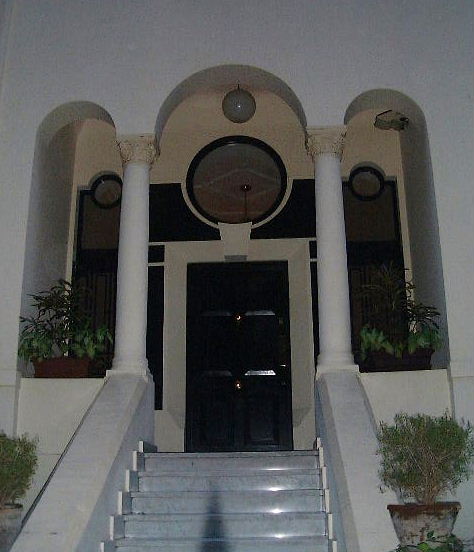
Entrance to No. 20 Ibn Zanki Street
Also among those initial tenants were several irrigation engineers credited with building the first Aswan dam and a dozen or so primary and secondary sluices in Egypt's Delta. Three engineers were famous enough so that Zamalek streets named after them: Sirs Wilcocks, Moncrieff and Garstin.
DOMAINS ADMINISTRATION
TO LET--- Officials are informed that one of the Government houses at Zamalek, No. 14 Sharia Shagaret el Dor and a plot of garden adjoining it, 1021 metres in area, are to let.
The rent of the house is L.E. 170 and that of the garden L.E. 12.250 milliemes per annum, the lease to expire on December 31, 1919.
Any officials desirous of taking the house and garden on these terms should apply to the Director General, Domains Administration, Sharia Bulaq, Cairo. All such applications should reach the Director General before August 31, 1917.
Journal Official No. 70 du 23 Aout 1917
|
After the Engineers came the economic and political advisors such as Walter Smart, Sir Alexander Keown Boyd et.al.
Those in the know would tell you Sir Walter was the chief intelligence officer in Egypt. But to the outsiders he was the all-important Oriental Secretary, one of the minor key positions in the Middle East. Invariably this meant he was the ablest hand at the British Embassy when it came to understanding the locals. "He's the Englishman who'll put these fellows in their places, and keep 'em there!" is how a seasoned colonialist described 'Smartie's' position.
By tradition the three villas at the western end of Ibn Zanki Street were reserved for senior members of the official British community in Egypt. While Nos. 19 and 20 are still with us today, No. 22, by far the largest of this unique collection of homes, was replaced in the 1950s by an elegant apartment building designed and owned by architect Ali Labib Gabr.
Hardly anyone remembers that up to the end of WW2, Nos. 20 and 22 were contiguous and that the street separating the two plots today then ended at their northern sidewalk. Indeed, with the Brits still in command, no one in his right mind was going to axe part of Sir Thomas W. Russel Pasha's award-winning garden. He was after all still the Commandant of the Cairo Police.
But even before Mansour Mohammed Street reached out to Gabalaya Street, some of the villas in question had started to change hands. As a result Walter Smart's intelligence-gathering duty was enhanced when one of the more significant 'locals' moved in next-door.
Engineer Hussein Sirry Pasha was not only a pro-British prime minister but he was also the Queen's uncle. Had he wanted to, all Smartie had to do in order to fill in his daily reports was to sit quietly under his mango tree and listen in on King Farouk's wartime conversation floating across the hollyhocks hedge that separated No. 19 from No. 17 Ibn Zanki Street (today the Tunisian Ambassador's residence).
It was only when other privileged Egyptians started to move in that the heretofore anachronistic term Anglo-Egyptian took up a new connotation: Toplofty Anglos and Egypt's elite living together as enlightened neighbors.
But not for long! There would be 1952 followed by 1956.
After the Suez Canal debacle of 1956, the British, as far as Egypt was concerned, were history. From the original 19 Zamalek villas, the now unpopular British Embassy held on to half a dozen the rest having been acquired by a variety of Egyptians from the political, cultural and diplomatic worlds.
As urban laisser-faire gradually replaced zoning laws and as the price of the square meter started its spiraling ascent in the late 1970s, it was inevitable that all of Zamalek's villas were in peril. Who in his right mind would sit on a plot of real estate worth millions simply for the privilege of saying "I have a garden!"
With the on-going real estate boom and the exorbitant expenses of maintaining a villa by financially challenged Egyptians (or foreign governments I may add), only nine of the original 19 made it into the 21st century. Four of these belonged to the British government. I am purposefully using the past tense because the Embassy's two villas adjacent to Salah el Dine Street have just been sold.
With this latest development I think you'll all agree that by simple extrapolation based on past events, one can reasonably assume they will be torn down while the rest of Zamalek looks the other way.
Two down, seven to go.
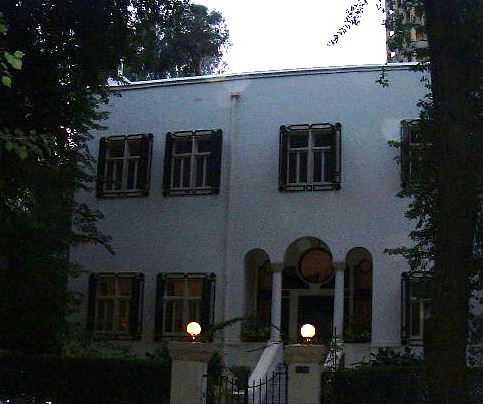
No.20 Ibn Zanki Street
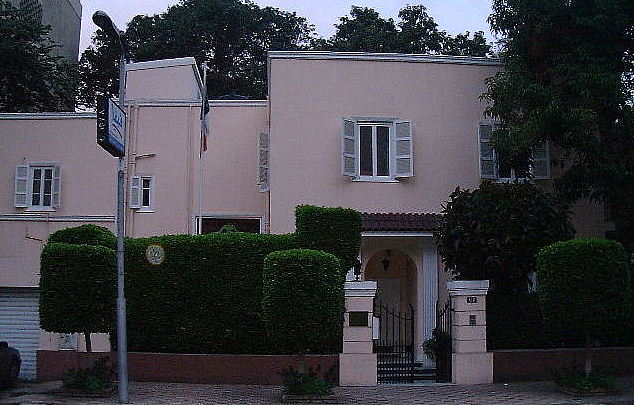
Irish Embassy residence No. 8 Shagaret el Dorr Street
References on Ernest Richmond: Richmond, E. T. "Review of The Works of Sultan Bibars at Bunduqdārī in Egypt
(sic), by K. A. C. Creswell" in JRAS. 1927.
Richmond, Ernest T. "The Significance of Cairo" in JRAS. 1913. 23-40.
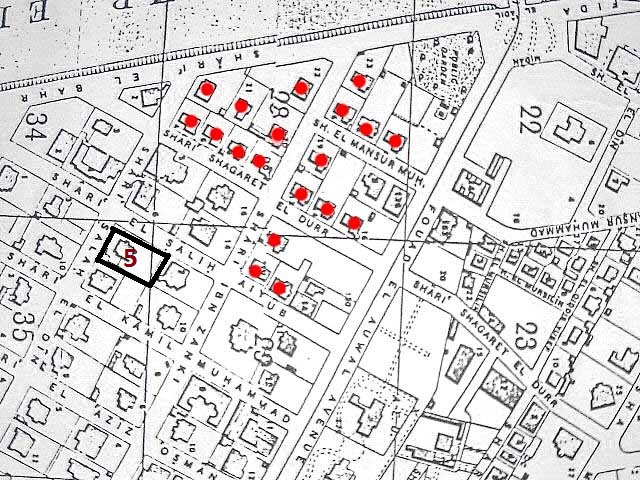
Zamalek map 1936
THEY LIVED IN THE RICHMOND VILLAS. (source: LE MONDAIN EGYPTIEN--WHO'S WHO, 1936-7)
Watson, Sir F.P., conseiller financier du governement egyptien, 15 Ibn Zanki
Smart, Walter A., secretaire oriental a la Residence, 19 Ibn Zanki
Mooro, Dr. Abdelwahab, chirurgien, 23 Ibn Zanki
Kelly, David Victor, conseiller de la Residence, 20 Ibn Zanki
Russell, "Lewa" Thomas Wentworth Pasha, Commandant Police du Caire 22, Ibn Zanki
Gamaleldine, Ali Pasha, ancien ministre, 4 Shagaret el Dorr
Mahmoud Shawky Pasha, secretaire prive de SM le Roi, 6 Shagaret el Dorr
Ibrahim Chourbagui Bey, medecin, 10 Shagaret el Dorr
Hussein Sirry Bey, sous-secretaire d'etat aux travaux publiques, 12 Shagaret el Dorr
Gharabali, Mohammed Naguib Pasha, ancien ministre, 16 Shagaret el Dorr
Keown-Boyd, Alexander, directeur generale departement de l'Europe, min. interieur, 10 Saleh
Ayoub
Chaker, Ahmed Mahmoud Bey, directeur generale irrigation de la Basse Egypte, 12
Saleh Ayoub
Greaves, R. Hathorn, 8 Mansour Mohammed
No 5 Saleh Ayoub
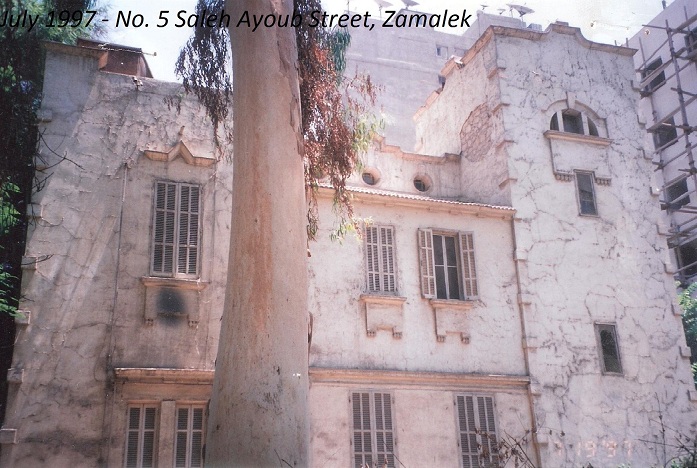
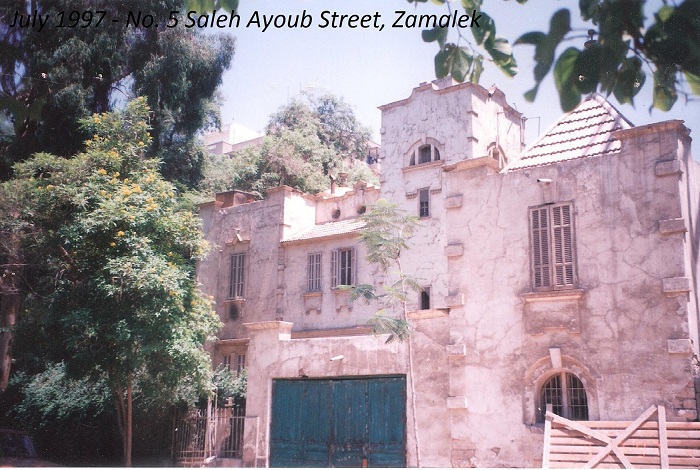
Like the Richmond prototypes, No. 5 Saleh Ayoub Street was one of Zamaleks earlier villas. Constructed during the first decade of the 20th century it was occupied by several British administrators in the Egyptian government. Later, during the interwar years, it became the designated residence of senior members of the British Embassy. The last two were Henry Lennox d'Aubigne Hopkinson (first baron Colyton) and his wife Alice Labonisse, who were replaced in 1943 by Sir Alexander Keown-Boyd.
Later No. 5 was occupied by Khadiga Fouad Izzet, a descendant of Viceroy Mohammed Ali from the Mustafa Fazil (Fadel) branch. Her son, Mohammed-Ali Mamdouh Riad, was a member of the Egyptian national fencing team which perished in the August 1958 KLM plane crash off the coast of Ireland. Purchased in the latter part of the century by shoe magnate Mohammed Mahmoud, his heirs sold the villa as an empty lot to the Libyan government shortly before the fall of Maamar Kadafi.
Reader Comments
|
Subject: Zamalek
Date: Sun, 13 Jun 2004 14:37:38 +0200
From: "Lini Janssens"
I accidentally discovered the zamalek chapter and am delighted. I lived for six years in Zamalek and notably at the triangular of Shagaret el Dorr with my grandmother Zeinab Omar al-Saqqaff whose brother Ibrahim was a prominent figure in Singapore.
Subject: Gezira Gardens
Date: Sat, 28 Apr 2001 14:18:04 +1200
From: Gill Dowson
I have been searching for any reference to an address (16 Zemalek, Gezira) that was associated with photo's of my father childhood in Egypt. This was their home and there are numerous photos of the house and gardens in about 1920.
So was really pleased to read your article on the history of the area. I do not know if the house is still there but at least now I have a modern address. I am travelling to Cairo in September 2001 and wanted to search out any old links.
Are the photos I have of any interest to you? they are mostly domestic scenes!
My grandfather was Ernest Dowson; he was director general of the survey of Egypt around WW1 time and later financial advisor to the Egyptian Govt. He was also involved in the commission of the first Egyptian stamps and other things. My father was an only child and he came to New Zealand in the 1950's.
Thanks for your article.
Regards
Gill Dowson
Subject: Zamalek
Date: Thu, 14 Dec 2000 17:33:34 -0800
From: "Yonas and Nancy Sadek"
Greetings from Victoria, B.C., Canada
Your article about El-Ghabalaya Street was of particluar interest to me as I was born and lived on Shagaret el-Durr Street, No.4, nearby El-Ghabalaya Street. It was the house of my maternal grandfather Ali Gamal el-Din Pasha, the Minister of War (1931-1933) in the elected government of Prime Minister Sidqi Pasha, and my grandfather lived there for 8 or 9 years.
No.4 is close to the Aquarium. I was born on Dec. 29, 1930 in my grandfather's house and lived with my parents and sister in an apartment in the neighbourhood just a couple of minutes walk from there. I attended the German kindergarten school in Zamalek. I remember that the house next to my grandfather's belonged to Mahmoud Shawki Pasha who was the secretary of King Fouad. Next to him lived Taher Pasha Noor, the General Attorney and next to him the house of Zaki el-Ibrashi Pasha, the Director of the Royal Estate.
Next to my grandfather toward the Aquarium was the corner house on a triangular lot of Ali Farid, a French National by the name of Clouet, a member of the Board of Directors of the Suez Canal. He became a Moslem in order to marry a beautiful Hegazi named Zeinab el-Saqqaff, the sister of the tycoon Omar el-Saqqaff who lived in Singapore and was the owner of a large rubber plantation on the Malayan peninsula. Zeinab's mother was a Turk, either the cousin or the sister of the mother of Hoda SharAawi.
I hope that this information may be of some interest to you if you are planning to write about another street in Zamalek.
I am interested in finding out about any newspaper articles, preferably with pictures, referring to my grandfather when he was the Minister of War (1931-1933) either in Arabic or other foreign languages. My grandfather was known among other things for his introduction of air forces into the army. Apparently he was often referred to in the newspapers as Gamal el-Din Pasha and the Seven Airplanes. I would be glad to pay for anyone to do the necessary research.
I am a retired professor of classical archaeology and have been in Canada for the last 38 years.
With warm regards
Mahmoud Sadek
Subject: Sir Alexander Keown-Boyd
It would amuse my father, who had a great sense of humour, to learn that he, who wielded such power and influence in his day, is now only remembered for his address in Zamalek --10 Sh. Saleh Ayoub where he and my mother lived for may years and where I spent my early childhood (I believe the house belonged to the Greek confectioner Lappas). After the war they moved to No. 5 in the same Street.
Henry G. Keown-Boyd (Herefordshire, UK)
Subject: AND THEN THERE WERE NONE - Cairo Times Nov 30,'00
Date: Sun, 10 Dec 2000 18:03:16 +0200
From: "Kamal Nabih"
Organization: MKN
CC: "Ahmad Nabeeh"
The era you are talking about ended round 1947/8. It was then that all these lovely old British colonial style villas, the Richmond Villas, were sold; except of course those already belonging to the British Embassy. At that time the Ministry of Public Works was responsible for many Departments that somehow grew to become the present Ministries of Water Resources, Habitation, Construction, Electricity and others; and was charged to handle the sales.
No.15 Ibn Zanki Street where we lived (after Sir Watson moved out circa 1938) was being sold for the meager sum, even then, of about LE14,000. My father who was then the one and only Under-Secretary of the Ministry of Public Works refused to buy it in view of possible conflict of interest. And that is how we moved to the Wahba building No.4 Ibn Zanki Street.
The Villas were sold : some owners continued to live in the villas, like Dr. Abdel Wahab Mooro Pasha in No.23 Ibn Zanki Street, Hussein Sirry Pasha in No.12 Shagarat El Dor Street (No.17 Ibn Zanki) and others, while other villas were pulled down and apartment buildings were erected in their stead like the Badrawi building No.15 Ibn Zanki (ex- Kamel Nabih Pasha), the Ali Labib Gabr building No.22 Ibn Zanki (ex- Russel Pasha). At the same time other villas, other than the Richmond Villas suffered the same fate, and Zamalek slowly sank into the labyrinth of high rises of today. All this started some years before 1952.
As for the Wahba building where my brother Ahmad Nabih lives (now still No.4 Ibn Zanki but also No.7 Aziz Osman), we believe that the only way today to find out the name of its architect is through the new owner (after the Wahba family who are now no more). The owner is Mohamad Azab who also owns the nearby building: No.4a Ibn Zanki Street and the chain of Pyramisa Hotels. He heightened the old Wahba building with some floors of new apartments and also put in a new lift. The architect who did all this new work must have used the original building drawings.
|
Email your thoughts to egy.com
© Copyright Samir Raafat
Any commercial use of the data and/or content is prohibited
reproduction of photos from this website strictly forbidden
touts droits reserves


